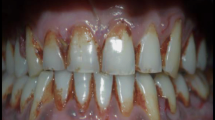Abstract
Mandible fractures are regularly encountered by maxillofacial surgeons and various treatment protocols are available for the management of these fractures. The aim of study compares the efficacy of open reduction and internal fixation of mandibular fractures with and without use of intra-operative inter-maxillary fixation. Twenty patients between age group ranging l8–65 years who reported with single mandibular fracture in Dental college in India, during Oct 2012–March 2015 were the study subjects. These patients were divided into two groups. In one group fracture reduction was done by using inter-maxillary fixation and miniplate fixation was done. In other group fracture reduction was done manually and then fractured fragments were held in position by the assistant and miniplate fixation was done. Post-operatively patients were evaluated for occlusion, bone alignment and soft tissue/hard tissue infection at 1st, 4th, 8th, 12th weeks in both the groups. Statistics done by using Spearman’s Rank correlation coefficient and Mann–Whitney U test. It was observed thatthere was no statistically significant difference seen in both the groups in terms of post-operative occlusion, radiological alignment and soft/hard tissue infection. Statistically significant difference was seen when the mean operating time was compared. The Group A showed mean difference of 35.50 min more time than Group B. The results of our study suggested that, use of intra-operative IMF does not show any advantages in terms of post-operative occlusion, bone alignment and soft/hard tissue infection. We have concluded from the study that the increased intra-operative time for the placement of IMF increases the cost of the surgery in regard to equipment and theatre time. There is no benefit in terms of radiographic and clinical outcome. Hence use of intra-operative IMF can be avoided for ORIF of single mandibular fracture.
Similar content being viewed by others
References
Mantos FP, Arnez MFM, Sverzut CE, Trivellato AE (2010) A retrospective study of mandibular fracture in a 40-month period. Int J Oral Maxillofac Surg 39:10–15
Bell BR, David WM (2008) Is the use of IMF necessary for successful outcome in ORIF of mandibular angle fractures. J Oral Maxillofac Surg 66(10):2116–2122
Nandini GD, Balaknshna R, Rao J (2011) Self tapping screws v/s ericharch bar for inter maxillary fixation: a comparative clinical study in the treatmentof mandibular fractures. J Maxillofac Oral Surg 10(2):127–131
Choi JW, Kim HB, Jeong WS, Kim SC (2019) Comparison between intermaxillary fixation with screws and an arch bar for mandibular fracture. J Craniofac Surg 30(6):1787–89
van den Bergh B, Blankestijn J, Tuinzing DB, Forouzanfar T (2015) Conservative treatment of a mandibular condyle fracture: comparing intermaxillary fixation with screws or arch bar. A randomised clinical trial. J Craniomaxillofac Surg 43(5):671–6
Florescu VA, Kofod T, Pinholt EM (2016) Intermaxillary fixation screw morbidity in treatment of mandibular fractures—a retrospective study. J Oral Maxillofac Surg 74(9):1800–1806
Batbayar EO, van Minnen B, Bos RR (2017) Non-IMF mandibular fracture reduction techniques: a review of the literature. J Craniofac Surg 45(8):1327–33
Patel N, Kim B, Zaid W (2016) A detailed analysis of mandibular angle fractures: epidemiology, patterns, treatments, and outcomes. J Oral Maxillofac Surg 74(9):1792–1799
Vadepally AK, Sinha R (2018) Is it better to bend wires occlusally or apically during placement of arch bars for intermaxillary fixation? Br J Oral Maxillofac Surg 56(1):67–69
Sharma M, Patil V, Singh R, Kulkarni S (2019) Role of intermaxillary screw fixation in maxillofacial trauma: a prospective study. Int J Appl Dent Sci 5(3):163–166
Rothe TM, Kumar P, Shah N, Shah R, Mahajan A, Kumar A (2019) Comparative evaluation of efficacy of conventional arch bar, intermaxillary fixation screws, and modified arch bar for intermaxillary fixation. J Maxillofac Oral Surg 18(3):412–418
Fordyce AM, Lalani Z, Songra AK, Hildreth AJ, Canon ATM (1999) Intermaxillary fixation is not usually necessary to reduce mandibular fractures. Br J Oral Maxillofac Surg 37(1):52–57
Qureshi AA, Reddy UK, Warad NM, Badal S, Jamadar AA, Qurishi N (2016) Intermaxillary fixation screws versus erich arch bars in mandibular fractures: a comparative study and review of literature. Ann Maxillofac Surg 6(1):25–30
Barodiya A, Thukral R, Agrawal SM, Chouhan AS, Singh S, Loksh Y (2017) Self-tapping intermaxillary fixation screw: an alternative to arch bar. J Contemp Dent Pract 18(2):147–151
Satpute AS, Mohiuddin SA, Doiphode AM, Kulkarni SS, Qureshi AA, Jadhav SB (2018) Comparison of Erich arch bar versus embrasure wires for intraoperative intermaxillary fixation in mandibular fractures. J Oral Maxillofac Surg 22(4):419–428
Kumar P, Menon G, Rattan V (2018) Erich arch bar versus hanger plate technique for intermaxillary fixation in fracture mandible: a prospective comparative study. Natl J Maxillofac Surg 9(1):33–38
Sandhu YK, Padda S, Kaur T, Dhawan A, Kapila S, Kaur J (2018) Comparison of efficacy of transalveolar screws and conventional dental wiring using erich arch bar for maxillomandibular fixation in mandibular fractures. J Maxillofac Oral Surg 17(2):211–217
Choi JW, Kim HB, Jeong WS, Kim SC, Koh KS (2019) Comparison between intermaxillary fixation with screws and an arch bar for mandibular fracture. J Craniofac Surg 30(6):1787–1789
Author information
Authors and Affiliations
Corresponding author
Ethics declarations
Conflict of interest
There are no conflicts of interest.
Additional information
Publisher's Note
Springer Nature remains neutral with regard to jurisdictional claims in published maps and institutional affiliations.
Rights and permissions
About this article
Cite this article
Bhushan, K., Unakalkar, S., Sahu, R. et al. Compare the Efficacy of Open Reduction and Internal Fixation of Mandibular Fractures With and Without Use of Intra-Operative Inter-Maxillary Fixation. Indian J Otolaryngol Head Neck Surg 74 (Suppl 3), 4096–4099 (2022). https://doi.org/10.1007/s12070-021-02830-3
Received:
Accepted:
Published:
Issue Date:
DOI: https://doi.org/10.1007/s12070-021-02830-3




